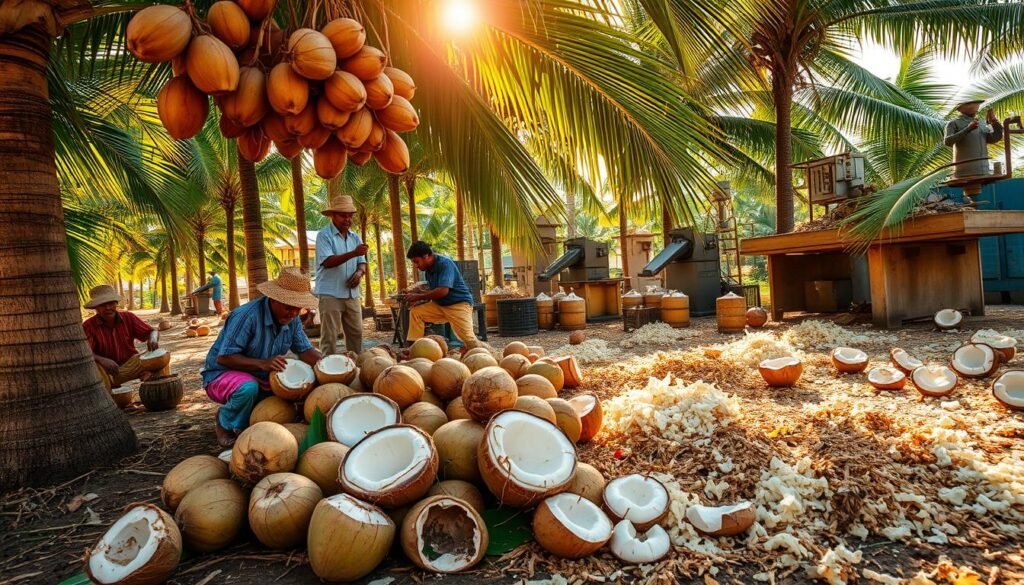What’s the big deal about coconut processing technology? It’s key in the coconut industry and affects how we make coconut-based products. India leads in coconut production, with each palm yielding about 80 nuts yearly. This shows how important efficient processing is.
We’ll look at coconut processing from start to finish. We’ll also see how coconut-based products are now a big part of our food world.
In the coconut world, knowing each processing step is crucial for quality products. Machines can de-husk up to 200 coconuts an hour. We’ll talk about how these steps affect the final product.
Key Takeaways
- The coconut industry is a significant sector, with India being one of the leading producers of coconuts globally, producing 13 billion nuts annually.
- Coconut processing technology is crucial for producing high-quality coconut-based products, such as desiccated coconut powder and virgin coconut oil.
- Efficient processing methods, including de-husking machines and copra processing, are essential for the industry.
- The average yield of coconut per palm per year is around 80 nuts, making efficient processing vital for maximizing production.
- Coconut-based products have become integral to the global food industry, with a diverse range of products available.
- Understanding the different stages of coconut processing is essential for producing high-quality coconut-based products.
- The coconut industry has a significant impact on the global economy, with the world trade in coconut oil increasing from 506,000 tons per year in 1964-1968 to 1.8 million tons in 1995.
The Rich History of Coconut as a Global Food Source
Coconut farming has been a big part of many cultures for thousands of years. It started in India and Southeast Asia. The coconut tree can grow up to 30 meters tall and is very versatile.
The Philippines is the world’s largest producer of coconuts. Since 2015, they’ve increased their export of fresh coconuts by over 80%.
The way we process coconuts has changed a lot. From old ways to new ones, it’s become more efficient. Now, we can make many products like coconut water, oil, and even dairy alternatives.
Ancient Origins and Cultural Significance
Coconuts have been grown for centuries. Genetic tests show they come from India and Southeast Asia. The coconut palm tree has both female and male flowers, which helps in cross-pollination.
This unique feature has led to many coconut varieties. Each one has its own special qualities.
Evolution of Coconut Processing Methods
How we process coconuts has changed a lot. Old methods used a lot of manual labor. Now, we use advanced equipment and technology.
This change has helped us produce more coconuts. It has also met the growing demand. Today, the coconut industry is worth billions of dollars worldwide.
Role in Australian Agriculture
Australia is important in the global coconut industry. Coconut farming and export help the country’s economy. The growth of the industry has created new jobs and opportunities.
As we keep improving how we process coconuts, the industry will grow even more. This will help the economy and create more jobs.
Understanding Different Coconut Varieties and Their Properties
It’s key to know about the many coconut varieties in a processing plant. Each type has special traits for different uses. For example, Malayan Tall and Thai Nam Hom coconuts are great for sweet coconut products because of their sugar content.
Some important coconut types include:
- West Coast Tall: known for its high yield and disease resistance
- Maypan: recognized for its aromatic flavor and high oil content
- Malayan Tall: has the highest sugar level at 6.15 °Brix
- Thai Nam Hom: has sugar levels ranging from 7.6 to 9.0 °Brix, depending on age
Knowing each variety’s properties is vital for processing. The fat, moisture, and sugar levels affect the final product. For instance, coconut milk and cream need special techniques to get the right taste and texture.

In a processing plant, we use each variety’s unique traits to make many products. This includes coconut milk, cream, desiccated coconut, and oil. By understanding these differences, we can make top-quality products for all kinds of customers.
Modern Coconut Processing Technology and Methods
We’re seeing big changes in how we process coconuts. These changes make coconut products better and more efficient. The coconut processing plant is now a place of innovation, using the latest machines and methods.
New technologies like dehydrators and centrifuges have changed how we dry and extract oil from coconuts. These tools boost the amount we get and make sure it’s pure and full of nutrients. Digital colorimeters and near-infrared spectroscopy (NIR) help check the quality and consistency of dried coconut.
Primary Processing Techniques
Primary steps include removing the husk, shell, and drying. New equipment has made these steps faster and better. This means we get higher quality products.
Advanced Processing Equipment
Modern gear like big dryers and advanced oil extractors are key in coconut processing today. They make the process more efficient and reliable.
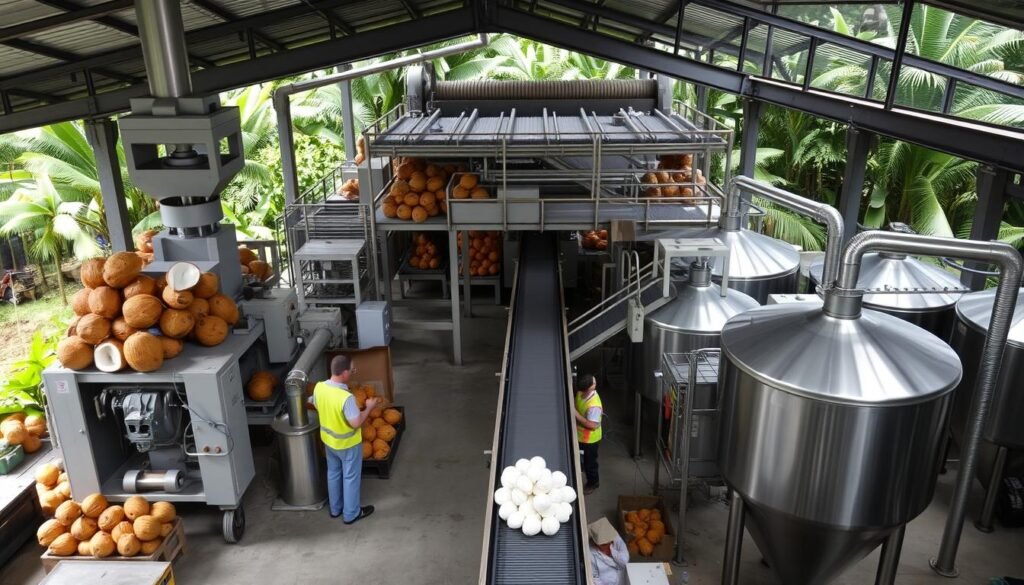
Quality Control Measures
Keeping quality high is crucial for coconut products. Using Artificial Intelligence (AI) and Machine Learning (ML) in checks helps find any problems. Traceability technology also makes sure everything is clear and open in the supply chain.
Essential Steps in Coconut Processing
Coconut processing starts with harvesting and ends with making products. We’ll cover the key steps in coconut processing. These include harvesting, dehusking, deshelling, and drying.
These steps are crucial for making many coconut products. Coconut processing methods change based on the product needed. But most involve drying, grinding, or extracting.
Products like desiccated coconut, coconut cream, and coconut oil are made through careful processing. Each product needs specific coconut processing methods for quality and consistency.
- One thousand coconut nuts yield about 130kg of desiccated coconut.
- One large coconut yields approximately 200ml of coconut cream.
- Coconut milk is dehydrated at a high temperature to produce a fine milk powder.
Understanding coconut processing and its methods shows the complexity of this industry. It highlights the need for quality control to make top-notch coconut products.
| Product | Production Process | Yield |
|---|---|---|
| Desiccated Coconut | Drying and grinding | 130kg per 1000 nuts |
| Coconut Cream | Extraction and centrifugation | 200ml per large coconut |
| Coconut Milk Powder | Dehydration and powderization | Varies depending on moisture content |
The Science Behind Coconut Product Development
Exploring coconut-based products requires understanding their science. The chemical makeup of coconuts is key to how they’re processed and what they become. From harvesting to packaging, each step is crucial to keep coconuts nutritious.
To analyze coconuts, we use tools like UV–VIS, IR, NIR, MIR, and RS. These tools help us check the quality and nutrition of coconuts. This info helps us make top-notch coconut products.
Chemical Composition Analysis
Coconuts are made up of many things, like fatty acids, proteins, and fiber. Coconut oil, for example, has special fatty acids that are good for us. Knowing what’s in coconuts helps us process them better.
Nutritional Value Preservation
Keeping coconuts nutritious is important. We use methods like cold pressing and centrifugation to get oil and milk without losing nutrients. This makes coconut products full of good stuff for our health.
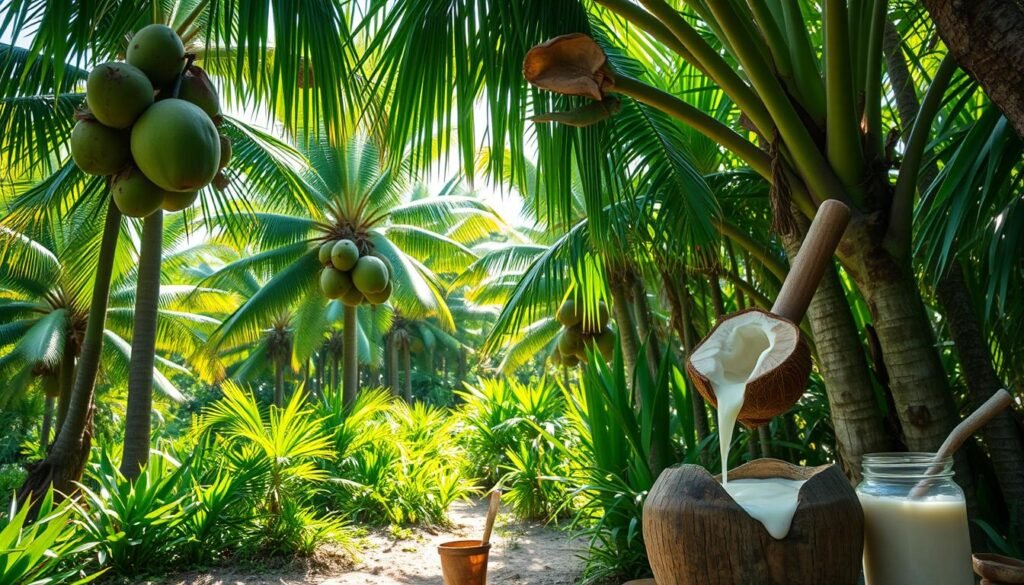
Processing Parameters
How we make coconut products depends on what we want. For example, making virgin coconut oil needs careful control of temperature and pressure. This keeps its health benefits. Making coconut milk and cream also needs careful control to get the right taste and texture.
Understanding coconut science lets us make many products for different needs. From coconut water to sugar, the options are endless. As the coconut industry grows, we’ll see even more new products.
| Coconut Product | Production Method | Nutritional Value |
|---|---|---|
| Coconut Oil | Cold Pressing | High in MCFAs, rich in antioxidants |
| Coconut Milk | Centrifugation | High in fiber, protein, and healthy fats |
| Coconut Water | Harvesting and Packaging | Low in calories, rich in electrolytes |
Commercial Products from Processed Coconuts
We have many coconut-based products available, like coconut water and desiccated coconut. These are made through various methods, such as cold-pressing for Virgin Coconut Oil (VCO) and refining for Refined Coconut Oil.
Coconut water is the clear liquid from young coconuts. It’s popular as a drink and sold in bottles. Desiccated coconut comes in different grades and is used in sweets, baked goods, and curries. Other products include coconut sugar, coconut copra, and coconut vinegar.
Some key coconut products and their uses are:
- Coconut oil: cooking and industrial uses
- Desiccated coconut: in sweets, baked goods, and curries
- Coconut water: as a drink
- Coconut sugar: a natural sweetener
- Coconut copra: for extracting oil
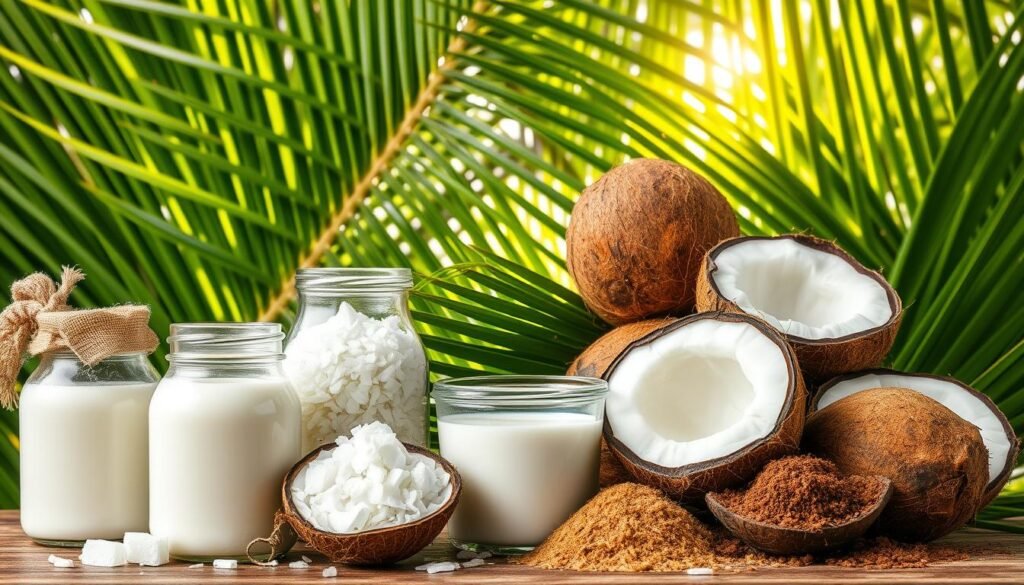
Coconut industries are growing due to more cultivation and use at home and globally. Countries like Sri Lanka and India are big producers and exporters. Sri Lanka is the fourth-largest exporter of coconut products worldwide.
| Product | Description | Uses |
|---|---|---|
| Coconut Oil | Extracted from fresh coconut meat or dried coconut (copra) | Cooking, industrial applications |
| Desiccated Coconut | Dried and shredded coconut meat | Confectionery, baked goods, curries |
| Coconut Water | Clear liquid from young green coconuts | Hydrating beverage |
Sustainable Practices in Coconut Processing
We’re dedicated to making the coconut industry greener. Using eco-friendly methods in coconut processing is key. We focus on managing waste and saving energy to lessen our environmental impact.
One cool way we manage waste is turning coconut shells into activated carbon. This stuff is great for cleaning air and water. It’s a win-win, cutting down on waste and boosting our profits.
Here are some key benefits of sustainable practices in coconut processing:
- Reduced environmental impact
- Improved energy efficiency
- Increased revenue streams
- Enhanced brand reputation
By choosing green practices, we help the coconut industry thrive. We’re also making the world a greener place.
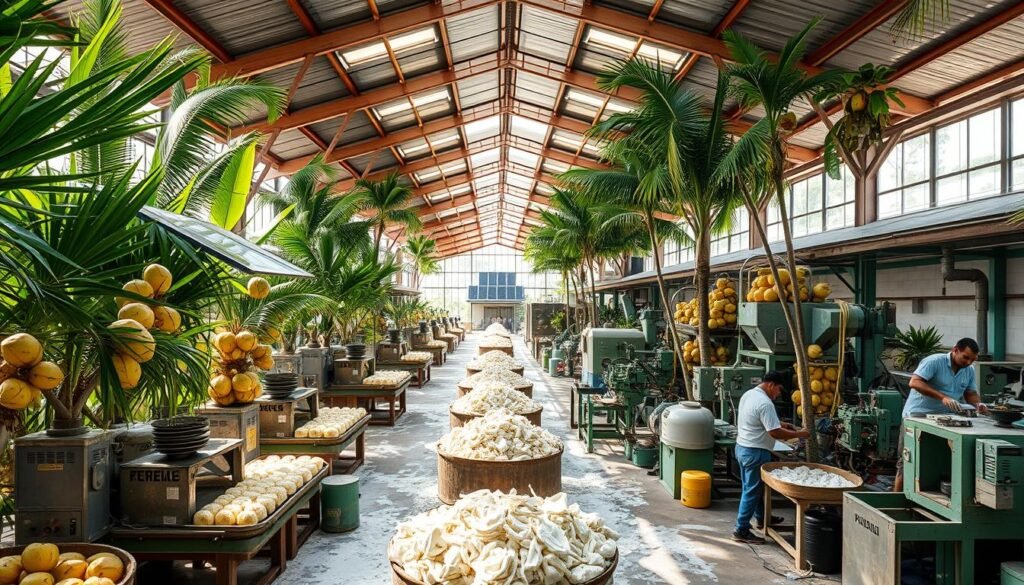
We’re all about growing sustainably in the coconut industry. Our goal is to keep our environmental footprint small. Together, we can build a greener future for the coconut industry.
| Benefits | Description |
|---|---|
| Environmental Benefits | Reduced waste, improved energy efficiency, and minimized carbon footprint |
| Economic Benefits | Increased revenue streams, improved brand reputation, and reduced operational costs |
| Social Benefits | Enhanced community engagement, improved working conditions, and increased job opportunities |
Machinery and Equipment Solutions for Coconut Processing
Exploring coconut processing reveals the importance of machinery and equipment. In a coconut processing plant, different machines work together. They turn coconuts into various products. We suggest using Li An machinery, like their Fruit/Gourd Peeling machine, to improve operations.
The Li An Fruit/Gourd Peeling machine is a breakthrough for the industry. It offers features that make peeling easier. This machine can handle lots of coconuts while keeping product quality high. It fits well with other equipment, like dehuskers and dryers, for a smooth production line.
Key Features of the Li An Fruit/Gourd Peeling Machine
- High processing capacity to handle large quantities of coconuts
- Precise specifications to maintain the quality of the final product
- Easy to operate and maintain, reducing downtime and increasing productivity
Adding the Li An Fruit/Gourd Peeling machine to a plant boosts efficiency and productivity. This leads to higher profits. As coconut product demand rises, investing in the right gear is key to success. With this machine, plants can produce high-quality products and meet consumer needs.
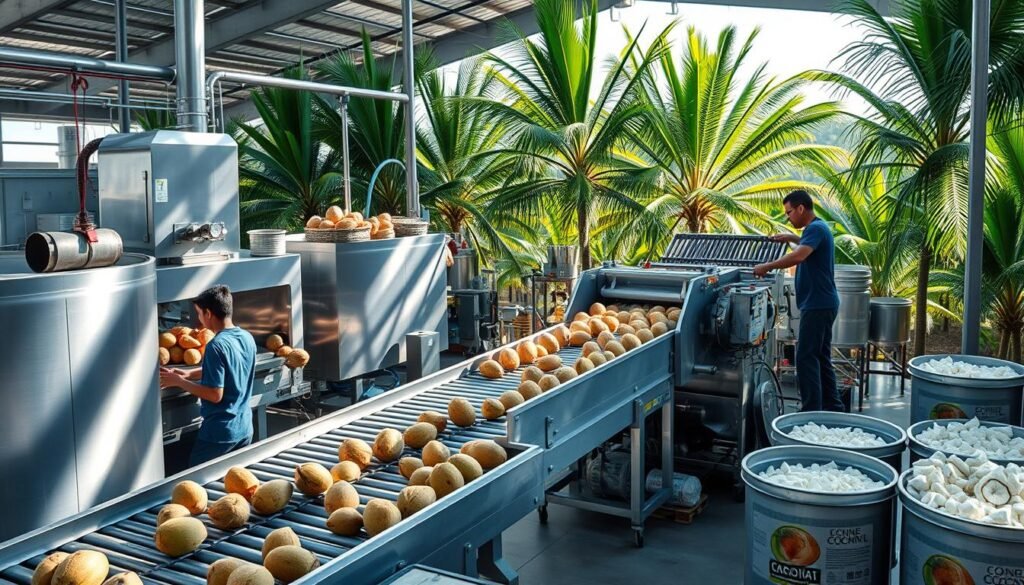
Conclusion: Advancing the Future of Coconut Processing
The coconut processing industry is on the brink of a big change. This change comes from new consumer tastes, tech advancements, and a focus on being green. We’re expecting to see a lot of growth and new ideas in the coming years.
More people want coconut products like oil, desiccated coconut, coconut water, and drinks. This shows the industry is strong and can change with the times. We think coconut exports will keep growing as companies use the latest tech to make their products better and more reliable.
We’re excited for the future of coconut processing. We want to keep making it better through green practices, smart investments, and always looking for new ways to do things. By using technology and caring for the environment, we can make sure the coconut industry keeps growing and meets the needs of people all over the world.
FAQ
What is the history of coconut as a global food source?
Coconut has been a key food for many cultures for centuries. It started in ancient times and is now a staple in many diets. We’ll look at how it became important in Australia’s agriculture and food industry.
What are the different varieties of coconuts and how do they impact processing?
Knowing about coconut types is key for good processing. We’ll explore the different coconuts, like the West Coast Tall and Maypan. We’ll see how each type affects processing in today’s plants.
What are the latest advancements in coconut processing technology?
We’ll check out the latest in coconut processing. This includes new methods like dehusking and deshelling. We’ll also look at the top-notch equipment and quality control steps used today.
What are the essential steps involved in coconut processing?
We’ll cover the whole coconut processing journey. This includes harvesting, dehusking, deshelling, and drying. We’ll talk about each step and why they’re important.
How does the science behind coconut product development work?
We’ll dive into the science of coconuts and how it affects processing. We’ll look at how to keep coconuts nutritious during processing. We’ll also discuss the important steps to control quality.
What are the diverse commercial products derived from processed coconuts?
We’ll look at the many products made from coconuts. This includes coconut water, desiccated coconut, and coconut oil. We’ll see how new tech has made more coconut products available.
What sustainable practices are being adopted in coconut processing?
Sustainability is key in coconut processing now. We’ll talk about green practices, waste management, and energy saving in modern plants.
What are the key features and specifications of the Li An Fruit/Gourd Peeling Machine?
We’ll focus on the Li An Fruit/Gourd Peeling Machine. We’ll discuss its special features and how it improves coconut processing. We’ll look at its capacity and specs to see why it’s a big deal.
Source Links
- Coconut processing – https://www.slideshare.net/slideshow/coconut-processing/76455971
- PDF – https://www.fao.org/fileadmin/user_upload/inpho/docs/Post_Harvest_Compendium_-_Coconut.pdf
- Harvesting and Post-harvest Management – https://coconuthandbook.tetrapak.com/chapter/harvesting-and-post-harvest-management
- Cracking Coconut’s History – https://www.aramcoworld.com/en/articles/2017/cracking-coconuts-history
- Coconut – https://en.wikipedia.org/wiki/Coconut
- Coconut Food Production – https://coconuthandbook.tetrapak.com/chapter/coconut-food-production
- Knowledge Based Information on Coconut :: Coconut Processing – http://www.agritech.tnau.ac.in/expert_system/coconut/coconut/coconut_processing.html
- Composition – https://coconuthandbook.tetrapak.com/chapter/composition
- The Role of Technology in Improving Desiccated Coconut Quality – OilCocos – https://oilcocos.com/articles/technology-improving-desiccated-coconut/
- Coconut Products Manufacturing – Celebes Coconut Corporation – https://www.celebes.com/blog/how-manufacturers-produce-coconut-products/
- The Complete Book on Coconut & Coconut Products – https://www.linkedin.com/pulse/complete-book-coconut-products-ajjay-kumar-gupta
- TNAU Agritech Portal :: Post Harvest Technology – https://agritech.tnau.ac.in/postharvest/pht_plantationcrop_coconut.html
- Frontiers | Innovations and trends in the coconut agroindustry supply chain: A technological surveillance and foresight analysis – https://www.frontiersin.org/journals/sustainable-food-systems/articles/10.3389/fsufs.2023.1048450/full
- Contemporary Developments and Emerging Trends in the Application of Spectroscopy Techniques: A Particular Reference to Coconut (Cocos nucifera L.) – https://pmc.ncbi.nlm.nih.gov/articles/PMC9147692/
- Coconut & Coconut Based Products – EDB Sri Lanka – https://www.srilankabusiness.com/coconut/sri-lankan-coconut-and-coconut-based-products.html
- Coconut Based Agro Industries – https://farmrise.bayer.com/pa/expert-article/coconut-based-agro-industries.html
- Processed coconut products – Coconut Seller India – https://coconutseller.in/processed-coconut-products/
- Coconuts – A sustainable raw material? – https://www.jacobi.net/coconuts-a-sustainable-raw-material/
- Coconut Waste Products, The Eco-Friendly Evolution – https://www.hanaccajava.com/coconut-waste-products-eco-friendly/
- Coconut Value Chain Analysis: A Systematic Review – https://www.mdpi.com/2077-0472/13/7/1379
- Starting a Coconut-Based Products Business – https://www.niir.org/blog/starting-a-coconut-based-products-business/
- Coconut Waste: Discovering Sustainable Approaches to Advance a Circular Economy – https://www.mdpi.com/2071-1050/16/7/3066

